Performance bikes are engineered with precision, making them fascinating machines that push the limits of speed and agility. You might think that a powerful engine is all that matters, but the reality is far more complex. From the intricacies of suspension systems to the importance of tire specifications, each component plays a critical role in overall performance. So, what are the top specs you should consider to maximize your racing experience? Let's explore these essential features that can elevate your ride to the next level.
Quick Takeaways
- Engine performance is crucial; consider displacement and weight-to-power ratio for optimal speed and maneuverability.
- A well-tuned suspension system enhances control and comfort, adapting to various terrains and riding styles.
- Tire specifications, including width, tread pattern, and rubber compound, significantly impact grip and performance on different surfaces.
- Brake system performance relies on hydraulic disc brakes and high-friction pads for reliable stopping power in all conditions.
Engine Displacement and Power
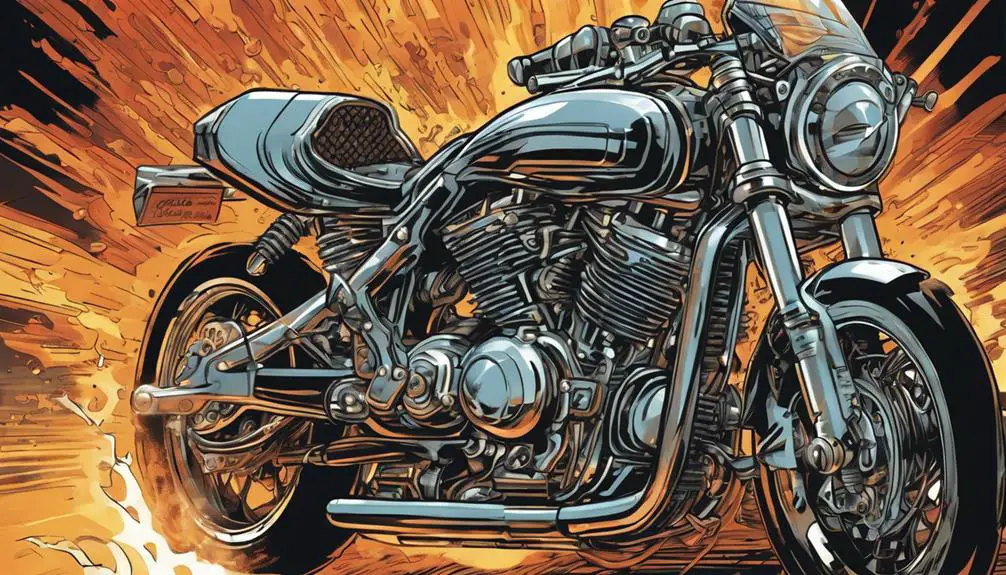
When it comes to racing bikes, engine displacement directly influences power output, making it a crucial factor for performance enthusiasts. You'll find that a larger engine displacement typically means more horsepower and torque, giving you the edge when you're tearing up the track. It's that exhilarating rush of speed that comes from harnessing raw power beneath you, allowing you to feel the freedom of the open road.
But don't overlook the balance between displacement and weight. You want a bike that's nimble, agile, and responsive, capable of carving through corners as easily as it blasts down straightaways. Think about what you crave: the thrill of acceleration or the mastery of control. The right engine size can help you achieve that perfect harmony.
As you explore your options, consider how displacement aligns with your racing style. Whether you're seeking a beastly engine for straight-line domination or a finely-tuned machine for technical tracks, understanding engine displacement is key.
It's not just about getting from point A to point B; it's about experiencing the liberation that comes with every twist of the throttle. Embrace that power, and let it drive you forward.
Suspension System Features
When it comes to suspension systems, understanding travel length, adjustability, and tuning options is essential for your performance bike.
These features directly impact your ride quality and handling, allowing you to tailor the setup to your unique style.
Let's explore how each aspect can enhance your racing experience.
Suspension Travel Length
Suspension travel length plays an essential role in how well your bike handles rough terrain, ensuring top control and comfort during high-speed rides. The right amount of travel helps you tackle obstacles without losing traction or stability. Here's why it matters:
- Improved Traction: Longer travel allows your wheels to stay in contact with the ground, enhancing grip on uneven surfaces.
- Increased Comfort: Adequate travel absorbs shocks and bumps, so you can ride longer without fatigue.
- Better Control: With the right suspension length, you'll navigate turns and descents with confidence, maintaining your bike's balance and performance.
- Versatility: Whether you're hitting the trails or racing on the track, the right travel length adapts to various terrains, giving you the freedom to explore.
When selecting a performance bike, consider how suspension travel length aligns with your riding style.
Don't settle for anything less than peak performance. Liberation on the road comes from equipment that empowers you to conquer every ride, and understanding suspension travel is an essential step towards that.
Choose wisely, and let your bike take you where you want to go!
Adjustability and Tuning Options
Adjustability and tuning options in a bike's suspension system let you fine-tune your ride for peak performance on any terrain. With features like adjustable preload, compression, and rebound settings, you can personalize your setup to match your riding style and the conditions you face. If you're hitting the trails, dial in a softer setup for better traction over rough terrain. Conversely, for those high-speed road races, a stiffer suspension can enhance stability and responsiveness.
You've got control at your fingertips. Most performance bikes come equipped with tools or even dials that allow you to make quick adjustments on the fly. This means you can react to changing conditions, whether you're carving through sharp corners or tackling rocky paths.
Don't forget about the importance of sag adjustment; getting the right sag guarantees your bike's suspension performs at its best at all times. By embracing these tuning options, you reveal the true potential of your ride, allowing you to conquer any challenge with confidence.
Weight-to-Power Ratio
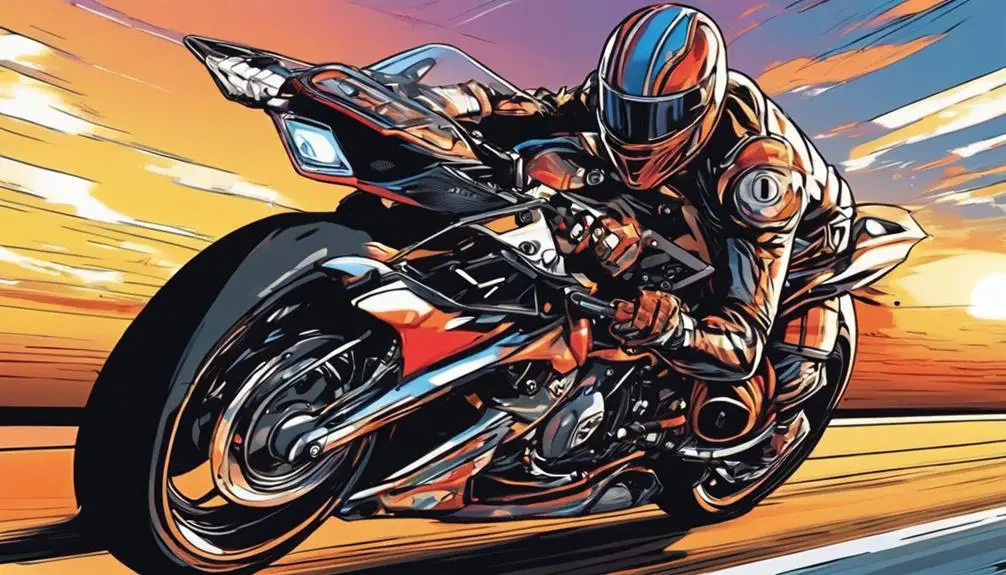
The weight-to-power ratio is an essential metric that directly impacts a bike's acceleration and overall performance on the track.
When you think about how quickly you can zip around corners or blast down the straight, this ratio becomes critical. A lighter bike with more power means you can release your freedom on the road like never before.
To maximize your weight-to-power ratio, consider these key factors:
- Engine Size: More displacement usually means more power. Finding the right balance is essential.
- Bike Weight: Aim for a lightweight frame and components. Every gram counts!
- Material Choices: Use materials like carbon fiber or titanium to reduce weight without sacrificing strength.
- Modifications: Performance upgrades like exhaust systems or tuning can enhance power without adding bulk.
Tire Specifications
When it comes to tire specifications, you need to take into account several key factors that impact your bike's performance.
Tire width can affect grip and handling, while the tread pattern plays an essential role in traction.
Tire Width Considerations
Choosing the right tire width can greatly impact your bike's handling and performance on various terrains. When you hit the road or trail, the width of your tires plays a significant role in how your ride feels and how efficiently you glide through different surfaces. Here are some key considerations to keep in mind:
- Traction: Wider tires provide more surface area, enhancing grip on loose or uneven terrain. If you crave freedom to explore, this is essential.
- Rolling Resistance: Narrow tires tend to roll faster on smooth surfaces, making them ideal for speed enthusiasts. If you're racing, this could be your ticket to victory.
- Comfort: A wider tire can absorb bumps better, allowing for a smoother ride. This comfort can liberate you from the fatigue of rough roads.
- Weight: Keep in mind that wider tires generally weigh more. If you prioritize lightweight performance, this could be a deciding factor.
Ultimately, consider your riding style and the terrains you'll conquer. The right tire width can empower your biking experience, letting you ride with confidence and freedom.
Tread Pattern Importance
Understanding tread patterns is vital for optimizing your bike's performance across different surfaces and conditions. The right tread design can greatly enhance your traction, control, and speed, allowing you to conquer various terrains with confidence. Different patterns serve unique functions—some prioritize grip on wet roads, while others excel on dry tracks.
If you often ride on mixed surfaces, look for a tread pattern that balances both grip and durability. Knobby designs can dig into loose terrain, giving you a solid hold on gravel or dirt, while slick patterns are perfect for maximizing speed on asphalt. The choice you make impacts how free you feel on your bike, empowering you to tackle any challenge that comes your way.
Moreover, consider how tread depth affects performance. Shallower treads can reduce rolling resistance on smooth surfaces, giving you a speed boost, while deeper treads provide better traction where it's needed. Remember, your bike's connection to the ground is essential; the right tread pattern can liberate your ride, transforming your experience from average to exhilarating.
Choose wisely, and let the road be your playground!
Rubber Compound Selection
Selecting the right rubber compound for your tires directly influences grip, durability, and overall ride performance. The choices you make here can either elevate your riding experience or limit your potential on the track.
To achieve the freedom and speed you crave, consider these key factors in rubber compound selection:
- Grip Levels: Softer compounds offer superior grip, perfect for tight corners and aggressive riding. However, they wear out quicker.
- Durability: Harder compounds last longer, making them ideal for endurance races. Balance your need for longevity with performance.
- Temperature Sensitivity: Different compounds perform better at varying temperatures. Choose a compound that matches your riding conditions for optimum performance.
- Tire Pressure Compatibility: Verify your chosen compound works well with your desired tire pressure. This can affect handling and comfort on the road.
Brake System Performance
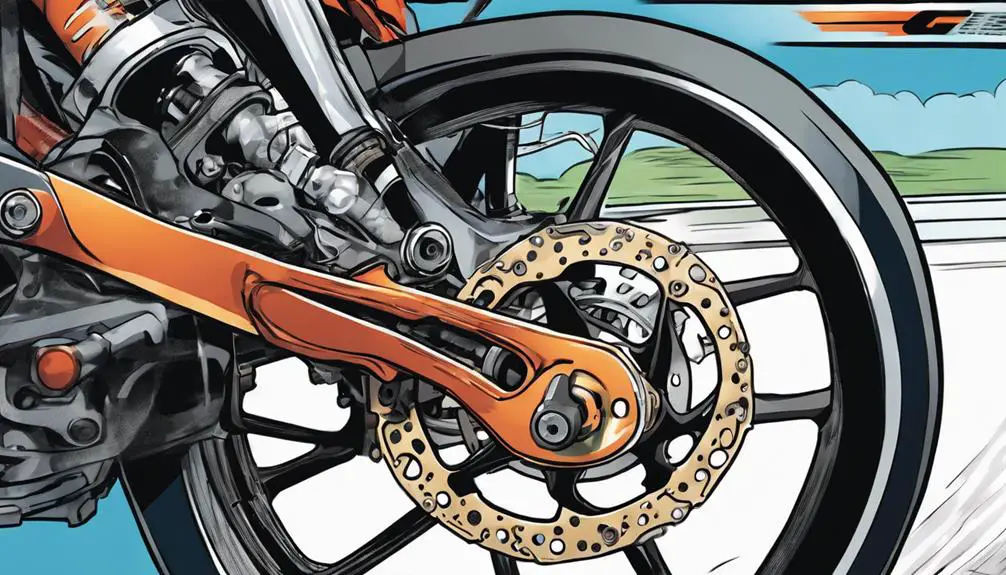
The brake system plays an essential role in guaranteeing your performance bike stops quickly and safely when you need it most. When you're pushing your limits on the track, having a responsive brake system can make all the difference. You want brakes that deliver consistent performance, allowing you to control your speed effortlessly.
Look for hydraulic disc brakes, which offer superior modulation and power. These brakes respond instantly to your commands, giving you the freedom to navigate sharp turns and sudden stops with confidence. Confirm your brake pads are made from high-friction materials, as they grip effectively in both wet and dry conditions, enhancing your overall riding experience.
Don't forget about the importance of brake lines and fluid. Opt for braided stainless steel lines to reduce flex and improve feel. Regularly check your brake fluid; fresh fluid helps maintain peak performance and prevents brake fade during intense rides.
Ultimately, a high-performing brake system empowers you to take control, releasing your potential on every ride. Invest in quality components and maintenance, and you'll experience the liberation that comes with knowing your bike will stop when you need it to—every single time.
Aerodynamic Design Elements
When it comes to performance bikes, aerodynamic design elements play a vital role in your speed and efficiency.
You should focus on optimizing frame geometry to reduce drag and improve handling.
Additionally, integrating aerodynamic components can greatly enhance your bike's overall performance.
Frame Geometry Optimization
Optimizing frame geometry is essential for enhancing aerodynamic efficiency and achieving higher speeds on performance bikes. A well-designed frame not only reduces drag but also allows you to maintain a powerful riding position. Here's how you can optimize your bike's frame geometry for peak performance:
- Lower Head Tube Angle: This creates a more aggressive riding posture, improving aerodynamics and stability at high speeds.
- Shorter Chainstays: A compact frame allows quicker handling and responsiveness, helping you navigate tight corners with ease.
- Longer Top Tube: This feature provides a stretched-out position that decreases wind resistance, allowing you to slice through the air effortlessly.
- Stiffness and Weight Balance: Ascertain your frame strikes the right balance between rigidity and weight. A lighter frame translates to faster acceleration, while stiffness improves power transfer.
Aerodynamic Component Integration
Integrating aerodynamic components into your bike design greatly enhances overall speed and performance. You want to feel that rush of freedom as you slice through the air, and the right aerodynamic elements can make all the difference.
Start with streamlined handlebars that reduce wind resistance, allowing you to maintain your speed with less effort. Consider aero wheels with a deeper rim profile; they help you glide smoothly, cutting through turbulence. A well-designed aero frame also plays a vital role—its sleek lines minimize drag and improve stability at higher speeds.
Don't overlook aero seat posts, which not only enhance your bike's look but also contribute to its aerodynamic efficiency.
Another key aspect is your riding position. Tucking in your elbows and dropping your torso can greatly lower your drag coefficient. Remember, every little detail counts; even the choice of clothing can impact your performance. Opt for tight-fitting, aerodynamic gear that complements your bike's design.
Gearbox and Transmission
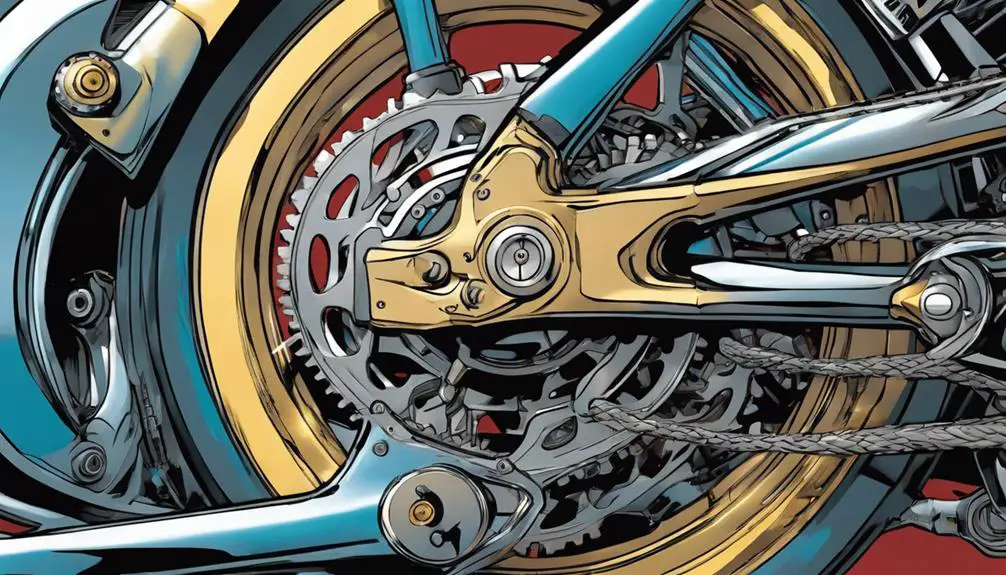
A high-performance gearbox and transmission system can dramatically enhance your bike's acceleration and overall handling on the track. When you're seeking that edge in speed and control, you want a system that responds instantly to your commands.
Here are four key aspects to focus on:
- Gear Ratios: Opt for adjustable gear ratios that let you fine-tune your power delivery. This flexibility helps you adapt to different track conditions and personal riding styles.
- Quick Shifter: Invest in a quick shifter for seamless gear changes without losing momentum. This feature allows you to focus on your lines and throttle control rather than fumbling with the clutch.
- Lightweight Components: Choose lightweight materials for your gearbox and transmission. Reducing weight improves your bike's agility and responsiveness, giving you the freedom to conquer corners with confidence.
- Durability: Go for high-quality, durable components. A robust system withstands the rigors of racing, ensuring consistent performance when you need it most.
With the right gearbox and transmission setup, you'll reveal your bike's true potential, giving you the liberation to push your limits on the track.
Frame Construction Materials
Choosing the right frame construction materials is essential for achieving the perfect balance of weight, strength, and rigidity in your performance bike.
You've got options like aluminum, carbon fiber, and titanium, each offering unique advantages that can liberate your riding experience.
Aluminum frames are lightweight and affordable, giving you a responsive ride while maintaining decent durability. They're great if you want a nimble bike without breaking the bank.
Carbon fiber, on the other hand, is the ultimate choice for performance enthusiasts. It's incredibly light, absorbs vibrations, and allows for innovative designs that can enhance aerodynamics. You'll feel the difference in every pedal stroke.
Titanium stands out for its unmatched strength-to-weight ratio. While it's pricier, its resilience and comfort make it worth considering if you're serious about long-term performance.
Ultimately, the choice of material should reflect your personal riding style and goals. Each option can set you free on the track or road, making it vital to select a frame that resonates with your aspirations.
Embrace the ride, and let the materials work in harmony with your passion for speed and adventure.
Fuel System Efficiency
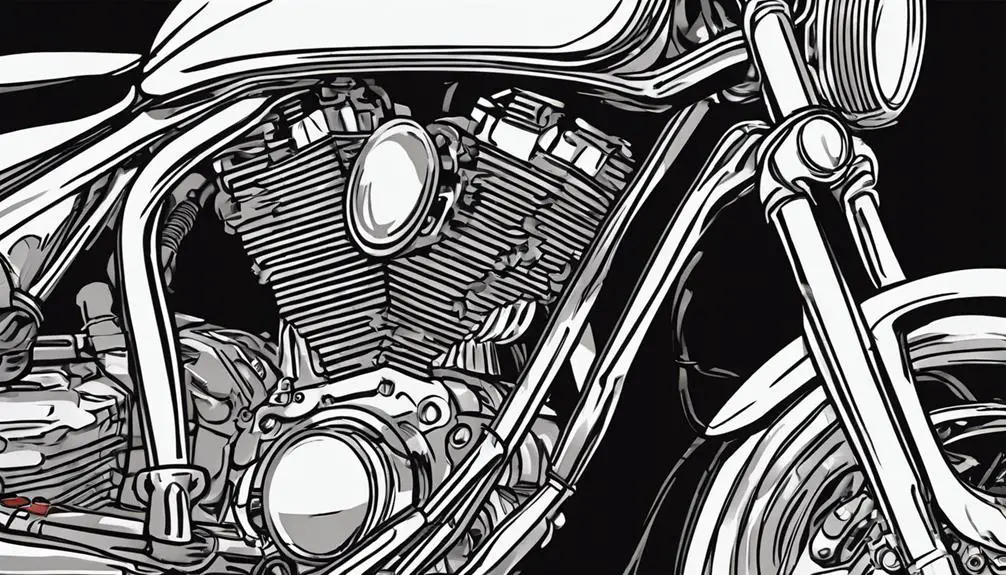
Maximizing fuel system efficiency can greatly boost your bike's performance and responsiveness on the track. When you fine-tune this aspect, you're not just improving speed; you're liberating your ride from unnecessary constraints.
Here are four key ways to enhance your fuel system efficiency:
- High-Quality Fuel: Always choose premium fuel to guarantee your engine runs smoothly and efficiently, reducing the risk of knock and maximizing power output.
- Fuel Injectors: Upgrade to high-performance fuel injectors that deliver a precise spray pattern and ideal atomization, giving your bike the freedom to breathe better.
- Air-Fuel Ratio: Pay attention to the air-fuel ratio. A well-balanced mixture not only boosts power but also enhances throttle response, allowing for a more liberated riding experience.
- Regular Maintenance: Keep your fuel system clean and well-maintained. Regularly check and replace filters, and clean injectors to prevent clogs and guarantee consistent performance.
Electronic Performance Enhancements
Electronic performance enhancements can greatly elevate your bike's capabilities, providing you with improved control and responsiveness on the track. These cutting-edge technologies, like ride-by-wire throttle systems and adjustable traction control, offer you the freedom to customize your riding experience. When you push the limits, these systems help maintain stability and grip, allowing you to release your true potential.
Consider advanced electronic suspension systems that automatically adjust to varying track conditions. You can ride with confidence, knowing your bike's handling is optimized for every turn. Additionally, data logging features provide real-time feedback, enabling you to analyze your performance and refine your technique with precision.
Don't overlook the benefits of quick-shifters, which allow seamless gear changes without clutching. This not only saves you time but also keeps your momentum intact, enhancing your overall speed.
Integrating these electronic enhancements gives you a competitive edge, turning your bike into a precision instrument of liberation. Embrace the technology, and you'll find yourself tearing down the track with unparalleled control and exhilaration. The future of racing is here, and it's time to seize the moment!
Common Questions
How Do Weather Conditions Affect Racing Bike Performance?
Weather conditions can seriously impact your racing bike performance.
If it's raining, you might struggle with traction, making your bike feel less stable.
Hot weather could lead to overheating, affecting your endurance.
Wind can slow you down or make you work harder to maintain speed.
Cold temperatures might stiffen your muscles, reducing your reaction time.
Staying aware of these factors helps you adapt your strategy and maximize your ride, no matter the conditions.
What Maintenance Is Required for Performance Bikes?
Picture yourself slicing through the wind on your sleek performance bike, the world blurring by.
To keep that thrill alive, you need regular maintenance. Check tire pressure, lubricate the chain, and inspect brakes for wear.
Clean the frame to prevent grime buildup, and replace worn-out parts promptly.
A little love goes a long way, ensuring your ride remains smooth and responsive, letting you conquer every road with confidence and freedom.
Are There Specific Tire Types for Wet Conditions?
Absolutely, there are specific tire types designed for wet conditions.
You'll want tires with deeper tread patterns that channel water away, enhancing grip on slippery surfaces.
Look for tires labeled as 'rain' or 'wet-weather' tires; they often use softer rubber compounds to maintain traction.
When you ride in the rain, these tires help you feel more confident and in control, allowing you to embrace the freedom of the open road, even when it's wet.
How Does Riding Style Influence Bike Performance?
Your riding style plays a vital role in bike performance.
If you lean into turns and maintain a steady grip, you'll enhance traction and control.
When you ride aggressively, you might push the bike's limits, maximizing speed but risking stability.
Conversely, a smoother, more relaxed approach can lead to better endurance and comfort.
Ultimately, understanding your style helps you adapt and get the most out of your ride, releasing your true potential on the road.
What Safety Gear Is Recommended for Racing?
When you're racing, safety gear is essential.
You'll want a high-quality helmet that fits snugly and meets safety standards.
Invest in a durable racing suit, gloves, and boots designed for protection and comfort.
Don't forget to add knee and elbow pads for extra safety.
You should also consider a back protector for added support.
Wearing the right gear not only safeguards you but also allows you to ride with confidence and freedom on the track.
Wrapping Up
To summarize, understanding these top racing specs can give you the edge you need on the track.
For instance, imagine your bike is equipped with an advanced electronic performance monitoring system, allowing you to fine-tune your settings mid-race. This could mean the difference between first and second place!
So, whether you're a weekend warrior or a serious competitor, focusing on these specs will enhance your riding experience and performance.
Don't underestimate their impact!